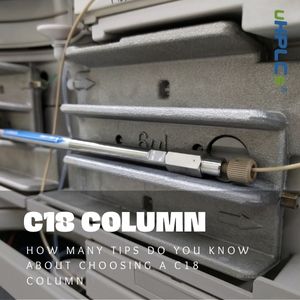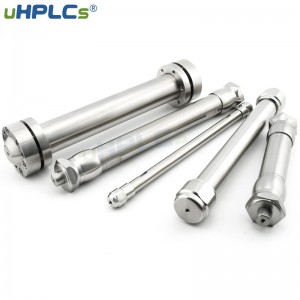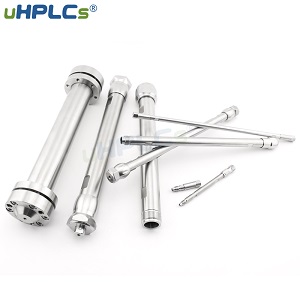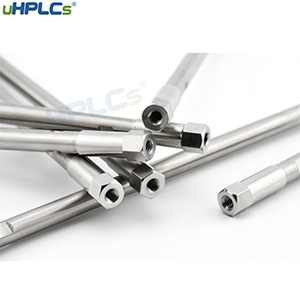High-performance liquid chromatography (HPLC) is widely used in drug analysis, and the choice of the column directly impacts the drug’s results and quality control. The retention behavior of different C18 columns varies widely, and selecting a suitable column is crucial for analyzing samples. This paper introduces the differences in the internal chemical bonding phase of C18 columns. It reviews the selection of the appropriate bonding phase under different conditions, such as pH, mobile phase polarity, and drug polarity, as well as the classification system of the columns, to provide a reference for the proper and rapid selection of C18 columns.

The high-performance liquid chromatography (HPLC) method is selective, sensitive, and fast and most soluble drugs can be analyzed by this method, so the technique has become the first choice for drug analysis. The column is the most important part of the HPLC system. It is often compared to the heart of liquid chromatography, as the type of column determines the nature of the chromatographic system, and the particle size and length affect the analysis time and efficiency. Normal phase columns such as amino, phenyl, and cyanide columns and reversed phase columns such as C18 and C8 are the most common columns used in drug analysis and evaluation work.
Reversed-phase chromatography with a chemically bonded silica stationary phase (C18 or ODS) of octadecylsilane has performed the task of liquid chromatography with distinction, and C18 reversed-phase chromatography has a distinct advantage over other chromatographic methods in that it can directly feed water-soluble samples for analysis and is therefore widely applicable, and is known as the “standard stationary phase separation mode.
C18 columns are the most widely used stationary phases for detecting species using liquid chromatography in national pharmacopeias. There are currently over 600 C18 columns on the market, and new columns are constantly being developed. When different C18 columns are used to analyze specific samples, the retention time, separation between solutes, peak order, and other retention behavior of the column may vary considerably. In some cases, the manufacturer of the column is also specified.
The USP recommended column brands and models can be found on the USP website. In contrast, the Chinese Pharmacopoeia only specifies the major types of column fillers, such as octadecylsilane bonded silica. The lack of detailed guidance on selecting columns in the Chinese Pharmacopoeia makes implementing pharmacopoeial recommended methods difficult. When an HPLC method is performed by reference to literature, when the column used in the literature is not available, a column of similar selectivity needs to be sought instead.
Differences in C18 columns
One of the first bonded stationary phases was octadecylsilane (often referred to as ODS or C18), a bonding phase made by reacting a silylating agent with an alkyl chain with a silanol group on the surface of silica gel. C18 columns exhibit different selectivity depending on the bonding method, particle size, length, and internal diameter. In this way, hundreds of C18 columns with different separation selectivity properties are available in the market.
The 2010 edition of the Chinese Pharmacopoeia added the examination of the substance and components in Macbethromycin A but did not specify the type and brand of C18 columns. C18 columns can achieve a good separation of the components in Macbethromycin A. The separation between different C18 columns varies considerably and affects the determination of substances and components of the drug.
C18 columns of the same size can also produce large analytical differences depending on the manufacturer. Five C18 columns of the same size and different manufacturers were used to determine thyroxine-related substances, resulting in a wide variation in the separation and retention time exhibited by the five C18 columns. Some of the columns did not even meet the requirements of Pharmacopoeia. Three C18 columns of the same size and different brands were used to investigate the effect of different manufacturers’ columns on the separation of sodium hydrocortisone succinate for injection from the substances of interest. The peak order of two of the C18 columns did not meet the requirements of the Chinese Pharmacopoeia. Hydrocortisone sodium succinate is very selective for the stationary phase of the columns. The main reasons for the above phenomenon are differences in particle size, pore size, bonding amount, and the process and technology of filling within the C18 columns.
Selection of C18 columns
The selection of a suitable C18 column in analytical chemistry can be based on the pH environment, mobile phase polarity, the classification system of the column, drug polarity, etc. Since the polarity of a drug is generally unchangeable in pharmaceutical analysis, the following section focuses on selecting C18 columns based on the pH environment, mobile phase polarity, and the classification system of the column.
1. pH environment For conventional C18 columns, the pH range used is usually 2 to 7, as the C18 stationary phase is limited at pH values above 8. Due to residual silicone hydroxyl groups, it is easy to cause irreversible adsorption of alkaline compounds, causing peak trailing and affecting separation and analysis. Low pH values will cause the bonded alkyl groups to fall off, and the separation of components will not meet the requirements.
(1) Selection of C18 under acidic conditions To improve the stability of C18 columns at low pH values, a spatial site-resistance approach has been proposed. Spatial site blocking refers to the attachment of larger groups that sterically hinder the attack of solute groups on the silanol group, allowing the silicone to regenerate and improving the resistance of the chemically bonded stationary phase to hydrolysis. Others have prepared C18 chemically bonded stationary phases containing isopropyl or isobutyl in the side chain. This chemically bonded stationary phase is more suitable for separating acids due to the introduction of larger side chain groups that sterically hinder the interaction between the residual silanol group and the solute and its ability to remain stable at low pH. C18) side chain groups, the space-site resistive key siloxane is bonded to the silica surface to avoid hydrolytic damage at low pH conditions, providing good stability and reproducibility under acidic mobile phase conditions. Stable Bond columns are, therefore, the preferred choice for low-pH method development. These columns may be preferred in the early stages of method development if the mobile phase is acidic.
(2) Selection of C18 under alkaline conditions The manufacture of chemically bonded phases for the rapid separation of alkaline compounds has been a hot research topic. A double-tooth bonded stationary phase contains two silicon atoms per silylated molecule, with the two silicon atoms linked by groups such as -O- or -CH2-CH2, each containing one C18 functional group. Its cyclic structure shows high stability and satisfactory column efficiency at low and high pH conditions. The most outstanding advantage of this chemically bonded stationary phase compared to the conventional single tooth chemically bonded phase is its stability at low, medium, and high pH values. Commercial columns using C18 double-tooth chemically bonded stationary phases include the Zorbax Extend-C18 column, which has a pH tolerance of 11.5 and is particularly suitable for the effective chromatographic separation of strongly basic compounds in high pH mobile phase conditions. The Zorbax Ex tend C18 column with a wide pH range was selected. The samples were analyzed, the impurities were alkaline, and the Zorbax Extend C18 gave the best separation between each impurity and component. If the separation between alkalis is poor, consider using a C18 column with the above-bonded phase packing

2. The Symmetry Shield TM RP C18 column is a reversed-phase column with a carbamate moiety embedded in it. ) for the HPLC analysis of berberine hydrochloride. The mobile phase in the experiment was strongly polar water, and berberine hydrochloride was a basic compound. Compared with other columns, the above column showed the highest theoretical column number without tailing. The bonded phase with embedded carbamate groups not only prevented the interaction between the residual silanol groups and the basic compounds but also improved the water wettability, which is particularly suitable for separating basic substances when using a polar mobile phase.
Chinese herbal medicines are more complex in composition and contain more polar, non-polar, and other components. In the study of the HPLC analysis of total saponins in the Haichangning formula, a Fusion-RP C18 column was used to achieve optimal separation between the various polar saponin fractions under strongly polar mobile phase conditions. The analysis of mixtures containing polar and non-polar compounds under strongly polar conditions.
3. When a column classification system repeats a method, but for some reason, the target column is not available, selecting a column with similar retention behavior to the target column is necessary to carry out the experiment. By characterizing the retention behavior of the columns, similar columns can be selected quickly. The method of reversed-phase chromatographic columns has been extensively studied since the 1970s. This column classification system allows the retention behavior of columns to be characterized, allowing for column selection and comparison.
Concluding Remarks
The retention behavior varies considerably between different C18 columns, and selecting the right C18 is a key focus of drug analysis work. A scientific method is needed to characterize and classify the columns before a rapid selection can occur. Currently, there is a proliferation of new types of C18 bonded phases, and it isn’t easy to classify them in terms of the type of bonded phase. Furthermore, the selection behavior of the column is not very dependent on the type of bonding phase. Therefore, this paper only discusses selecting a good C18 bonding phase for acid and base conditions and a durable C18 bonding phase for strong polar conditions but does not classify the columns in this way.
Post time: Feb-16-2023








